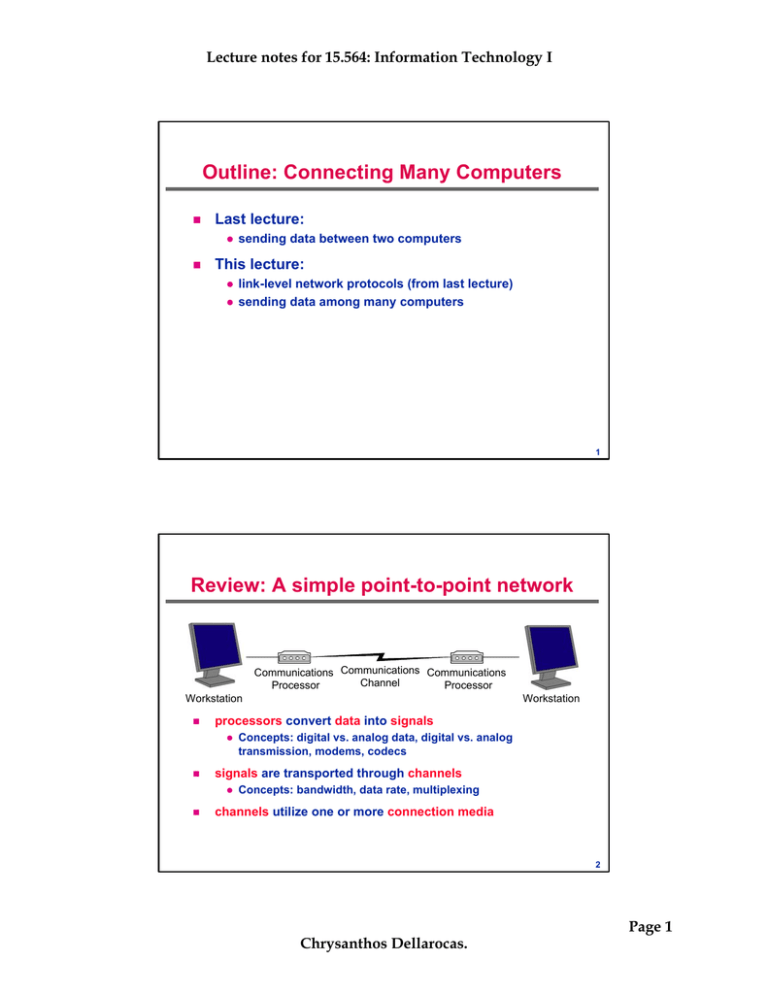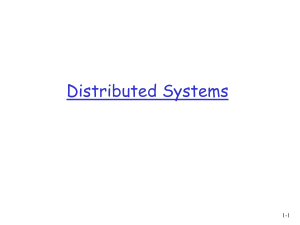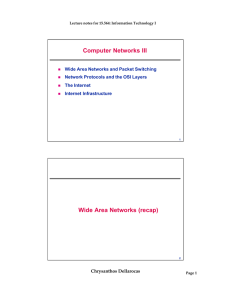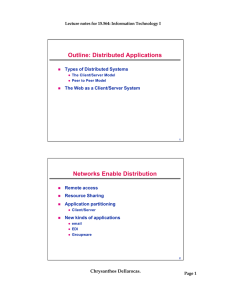Outline: Connecting Many Computers Lecture notes for 15.564: Information Technology I
advertisement

Lecture notes for 15.564: Information Technology I Outline: Connecting Many Computers � Last lecture: � � sending data between two computers This lecture: � � link-level network protocols (from last lecture) sending data among many computers 1 Review: A simple point-to-point network Communications Communications Communications Channel Processor Processor Workstation � processors convert data into signals � � Concepts: digital vs. analog data, digital vs. analog transmission, modems, codecs signals are transported through channels � � Workstation Concepts: bandwidth, data rate, multiplexing channels utilize one or more connection media 2 Chrysanthos Dellarocas. Page 1 Lecture notes for 15.564: Information Technology I Example: Analog data -­ digital transmission analog audio signal Sender 1 PBX Digitization 010110 011101111000 Time division multiplexing Digitization analog audio signal Sender 2 Fiber optic modem Digital telephone network Light pulses 111100 Telephone network (fiber optic cables) analog audio signal PBX Light pulses 010110 011101111000 Fiber optic modem Receiver 1 Digital-toanalog converter Demultiplexing 111100 Digital-toanalog converter analog audio signal Receiver 2 3 Connection Media � Twisted pair copper cables � � � Coaxial cable � � � 300BPS - 10MBPS Why twisted? Higher bandwidth, up to 200MBPS More expensive and difficult to wire Fiber optic cables � 10GBPS and higher data rates possible 4 Chrysanthos Dellarocas. Page 2 Lecture notes for 15.564: Information Technology I Fiber Optic Cables 5 Connection Media (Cont’d) � Wireless � Broadcast signals through the air - up to 100MBPS (~ like coaxial cable) Scarce resource; use regulated by FCC Can easily add another wire, but can’t easily add more wireless capacity 6 Chrysanthos Dellarocas. Page 3 Lecture notes for 15.564: Information Technology I Connecting many computers � Two basic approaches: � � use a shared broadcast connection medium use many point-to-point connection 7 Idea 1: Use broadcast medium � All computers are connected to the same connection medium � � Date sent by each computer can be “heard” by all computers in the network � � e.g. a coaxial cable How does each computer select only relevant data? All computers compete for access to the common medium � A little bit like computer buses 8 Chrysanthos Dellarocas. Page 4 Lecture notes for 15.564: Information Technology I Sharing Connection Media � Two general techniques for distributed control of shared resources � � � Prevent conflicts (locks, reservations, scheduling) Recover from conflicts Here the shared resource is a communications channel � � Several computers transmitting on single wire Or broadcasting in the same location 9 Method 1: Systematic Conflict Recovery � Example: CSMA/CD � When multiple devices share the same medium (wire) � Carrier Sense Multiple Access/ Collision Detect � � � If medium is idle, transmit If medium is busy, listen until idle, then transmit If a collision is detected - Send jamming signal to make sure all stations know Cease transmission Wait a random amount of time, then try again � What happens if load is heavy? light? � What happens if one node fails? � Used in Ethernet LANs Chrysanthos Dellarocas. 10 Page 5 Lecture notes for 15.564: Information Technology I Method 2: Temporary Reservations � Example: Token Ring � "Token" is a data signal in a particular format � When no node is transmitting, token just circles the ring � To transmit � � � � Wait for token Remove token Send data packet When data makes it back around, put new token on ring � What happens if load is heavy? light? � What happens if one node fails? � Used in IBM LANs, FDDI 11 Broadcast Network Technologies � Ethernet � � � cheaper and simpler to install unpredictable delays when load is heavy Token Ring � � more expensive and complex bounded delays even under heavy load 12 Chrysanthos Dellarocas. Page 6 Lecture notes for 15.564: Information Technology I Limitations of Broadcast Networks � OK for small numbers of computers � Cannot handle many computers � � too many conflicts Difficult to implement for wide-area networks � only wireless networks would work over long distances 13 Idea 2: Use many point-to-point connections � New concepts: � Routing � Which path do I follow to get from S to R? Switching - How is bandwidth allocated for the transmission of a message? 14 Chrysanthos Dellarocas. Page 7 Lecture notes for 15.564: Information Technology I Basic WAN structure Host Router Host Communication lines Router Router Host Router Router Subnet Host 15 Switching � Circuit switching � � � Set up dedicated end-to-end channel for duration of connection Used for phone network Message switching � For sending data messages (e.g., email) � � Each intermediate node stores and forwards the message No wasted channels as with circuit switching Packet switching � � Divide data messages into small packets Each packet is "message switched" - Packets can take different routes If one is lost, don’t resend whole message Chrysanthos Dellarocas. 16 Page 8 Lecture notes for 15.564: Information Technology I Why Packets? � If part of message is lost or garbled, resend only the affected packet(s) � Speed � Store-and-forward delay is minimized (pipelining) � Each intermediate node has to receive and store a message, then forward it A can send packet 1 to B while receiving packet 2 from S. Not possible if whole message sent at once Packets can take different routes (parallelism) - packet 1 goes S -> A -> B -> R packet 2 goes S -> C -> D -> R A B S R C D 17 Illustration of Pipelining (a) Message switching Each node waits to receive the entire message (packets 1-7) before it forwards it to the next node S 1 2 3 4 5 6 7 A 1 2 3 4 5 6 7 B 1 R 7 14 2 3 4 5 6 7 21 (b) Packet switching Each packet is immediately forwarded to the next node S 1 2 3 4 5 6 7 1 2 3 4 5 6 1 2 3 4 5 A 7 B R 6 7 7 8 9 18 Chrysanthos Dellarocas. Page 9 Lecture notes for 15.564: Information Technology I LAN (point-to-point) network protocols � “Data Link” protocols - provide point-to-point error-free transmission - break data into frames - attach error-detecting info into data - wait for acknowledgments and retransmit, if necessary - handle collisions (in broadcast networks) Communications Communications Communications Channel Processor Processor Workstation Workstation 19 Protocols for Packet Switching � Assume data link protocols provide error-free point-to-point transmission � Sender must break messages into packets - attach sequence number - attach destination address, other admin info to packets � Receiver must reassemble message from packets - use sequence numbers in case packets arrive out of order - request retransmission of lost, garbled packets � Intermediary nodes must route packet - find best next node in path for each packet - route packets to next node S A B C D R 20 Chrysanthos Dellarocas. Page 10 Lecture notes for 15.564: Information Technology I Flow Control and Routing � Flow control � � � � Nodes keep buffers of undelivered packets Buffers can fill Don’t send until network and receiver are ready Routing � Need several hops � Determined at session creation Or dynamically for each packet Put complete routing information into “packet header” - Or store some of routing information at the intermediate nodes - Just put final destination into packet header 21 Acknowledgments � Packets may arrive out of order � Packets may be missing � Stop and wait acknowledgement handling � � � Send just one packet Wait for ACK before sending another Sliding window acknowledgement handling � � Send several packets (numbered) Wait for ACK of first one before sending (n+1)st - ACKs must be numbered as well 22 Chrysanthos Dellarocas. Page 11 Lecture notes for 15.564: Information Technology I Error and Failure Detection and Handling � If packets out of order, reorder them! � � That’s why they’re numbered If packet missing from sequence, or unrecoverably garbled, send NACK 23 Chrysanthos Dellarocas. Page 12








